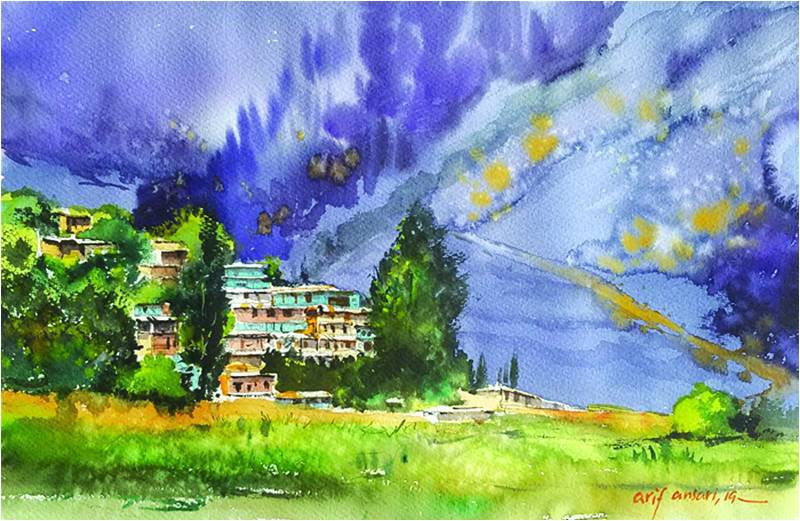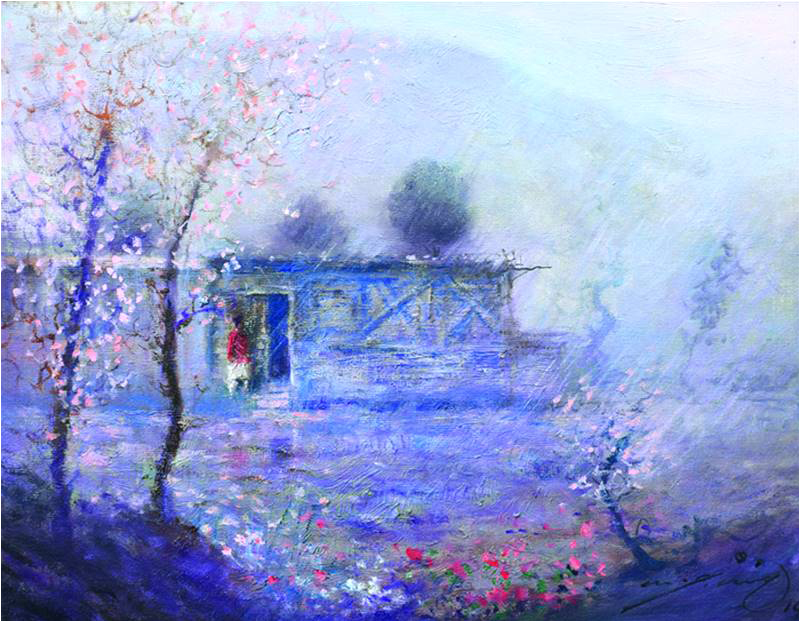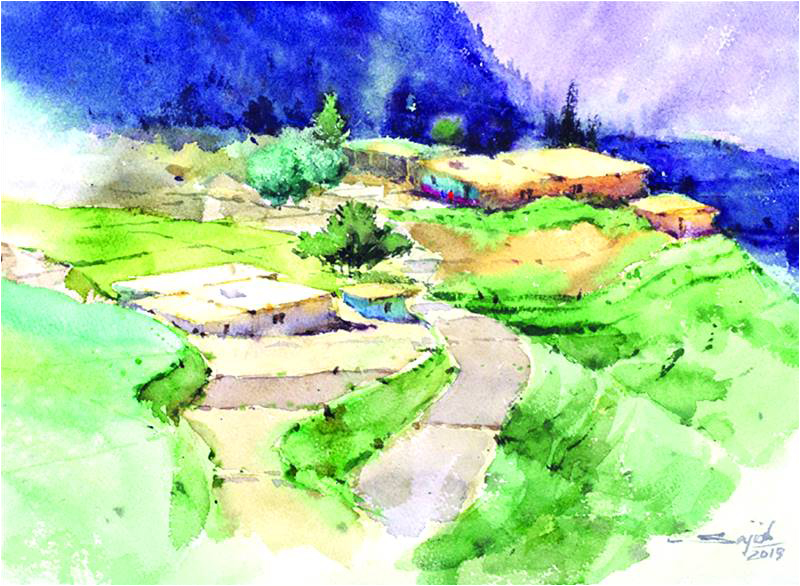
With such a poetic title and four such accomplished artists, one could not possibly be disappointed in this exhibition, which took place at Artscene Gallery, Karachi – illustrating many aspects of the Kaghan Valley, where the hub of tourism is the village of Naran, at 8,200 ft. The distinguished artists concerned are A.Q. Arif, Ajab Khan, Ali Sajid and Arif Ansari, who invite us to a world of landscape relatively unharmed by human habitation, though the signs of habitation are to be seen everywhere. All four artists have exhibited both at home and abroad. They have received a variety of awards, while some have taught at prestigious institutions.
Mountain scenery presents extremely varied symbolism, and its spiritual vitality can be powerful. Despite their uncanny and ominous quality, mountains are often uplifting to the spirit, and as they reach up from earth to sky they are symbols of the ascent from the earthly plane, while the rivers that descend through them separate two different spiritual realms. Valleys allow all life to flourish with ease, and are thus symbols of the created world in all its richness - though it is sometimes said that they may also be evil and ominous, as they are low-lying, and at the opposite pole from mountain summits.

The valley in question extends from the ill-fated Balakot to the Babusar pass at 13,690 ft, including such features as Lake Lulusar, which flows into the Kunhar River that rushes through the valley, as well as Jheel Saiful Muluk at 10,000 ft and from where one can see the picturesque Malika Parbhat. Elsewhere we see Danna Meadows, Batata Kundi - the last village to stay open all winter, and Lalazar, with its beautiful green slopes. And all through the summer one can see the nomads shepherding their livestock, their families and their household goods, down to places like Rawalpindi and Murree, where they can find temporary employment, until the return of warmth to their villages invites them back to the valley. If a lady tourist is caught up an embankment from which she cannot descend independently, she may even receive a proposal from the nomadic gent who helps her down.
One used to admire the scenic beauty of the Swat Valley, but one hears that today its rivers and beauty spots have been disfigured by huge piles of rubbish left behind by careless local tourists. But fortunately our four artists and many of their viewers have seen the Kaghan Valley long before any such devastation occurred here, or the notorious timber mafia employed their brand of expertise in deadly earnest.
Those of us who have been to this valley will recognize many if not most of the locations presented by the four artists on display, though in some cases they have given their own unique interpretations of these. A.Q. Arif, for example, graduated in 1966 from Karachi School of Art, and from his heart he tells us, “I paint the glories of nature and the magnificence of God. Through my work I help people acknowledge the simple fact that we all need to appreciate the beauty and harmony given to us by God. Beauty is not only in vibrant colours, peacocks and angelic creatures. It lies in the hand of Man and in the heart.” As a new graduate, first he was captivated by the beauty of the rural landscapes and the sense of space. Later he began to work on a larger scale, endeavouring to fuse history with nature, and became famous for his magnificent architectural views, redolent of history – half imaginary, half real.

However, “Tales of a Valley” is mostly a collection of scenes of country life in the Kaghan Valley. A.Q. Arif’s rustic “Day Start Batta Kundi” is an impressionistic early morning view of Batta Kundi, near Lalazar, towards the upper Kaghan Valley. What a contrast it is to his previous, elegant architectural pieces. It has a feeling of life, of expectancy, with the kitchen fires smoking, the livestock munching away, getting a good start to the day, while the blue mountains lit by the early morning sun in the background set off the humble cottage to advantage, and the dirt track in the foreground reminds us that we are in the heart of the countryside.
What a shivering contrast is his “Kitchen in Ice Land Batta Kundi,” so aptly named. One can feel the icy wind driving over the flimsy cottage and its surroundings, the rain it brings blotting out the mountain in the background. All this is ample proof of the artist’s understanding of nature, and of his time spent in this valley during its varied seasons.
The work of self-taught Ajab Khan, with its accurate photo-realism and appropriate colour has received considerable acclamation. Since his family’s move from India to Dera Ismail Khan his first exposure to colour was the dark liquid in a dyer’s cauldron, and colouring the black and white pictures in the family album from thin layers of paint that he had made from dyers’ pigments was his favourite childhood activity. Then he gained experience in printing and impressive calligraphy from working with signboard painters; but it is his pictures of his beloved Dera Ismail Khan that have won him national and international awards.
An example of his art is “Fragrance of Damdama,” followd by “Fragrance of Damdama 2,” though the former is more impressive. Damdama is a village near Naran. Its lines of houses, tier upon tier, built into the hillside, are a unique feature of this village, though the artist gives no hint of the glacier descending the mountains behind them. Due to its proximity to the Kunhar River, in its lush vegetation the generous display of purple flowers matches the lilac colour imparted to parts of the mountains behind the village. What a beautiful end to the day, though one observes that in much of the strictly V-shaped Kaghan Valley, the sun tends to set early.
Like all participants in this show, this artist has shown a variety of views of the valley. His “Spring” pictures – in which one admires the sparkling purity of the spring water – being particularly charming. But the queen of them all is “Morning Altar,” a view of the Kunhar River in full flow through Naran, while in the background two admirers stand on the bridge.
In the Head Office of UNESCO, also in the UNHCR office and the Urbino Museum, Italy, Ali Sajid’s cityscapes have created much interest, and he is known as well for his efforts to preserve Peshawar’s heritage. Naturally, therefore,he has won several international awards. He has taught as assistant professor at Sarhad University of Science and Technology in Peshawar, and has worked as art mentor in Tokyo and Singapore. Besides this he has conducted numerous workshops in Pakistan. Cityscapes, villages, humble dwellings, snow scenes, houses, green mountainsides - he has presented all this and more in watercolour on paper in this exhibition. So his work stands out in this show among all the oil-on-canvas pieces. “North Series 5” is the best of these, due to the soft outlines of all it contains, while the generous use of blue and the mist below the village add much to the tout ensemble.
As for variety in watercolour, Arif Ansari’s collection of village house is pleasing to behold. After his 4-year course at Mashkoor Art School, he took part in a number of national and international exhibitions, his work being seen in places as far apart as India and Italy. In his “Batta Kundi Series 8”, for example, one enjoys his contrast of orange and shadows. Elsewhere one admires his grey, naturally seasoned wooden cottage. However, his deep blue “Off Road Prince” is more likely king of them all, with its impact amongst the greenery. How long has it stood there, perhaps in want of repair? Viewers must wonder at the popularity of Batta Kundi as a subject. His dramatic contrast of village and purple mountain background (Batta Kundi No. 7 ), rather like “Fragrance of Damdama,” is the final proof of his sensitivity as an artist. This is a picture one would like to hang on one’s wall.
It does one’s heart good to see a landscape exhibition. There is variety found in the styles of painting, the media and the sense of freedom. And it reminds us that we, too,are part of nature.
Mountain scenery presents extremely varied symbolism, and its spiritual vitality can be powerful. Despite their uncanny and ominous quality, mountains are often uplifting to the spirit, and as they reach up from earth to sky they are symbols of the ascent from the earthly plane, while the rivers that descend through them separate two different spiritual realms. Valleys allow all life to flourish with ease, and are thus symbols of the created world in all its richness - though it is sometimes said that they may also be evil and ominous, as they are low-lying, and at the opposite pole from mountain summits.

The valley in question extends from the ill-fated Balakot to the Babusar pass at 13,690 ft, including such features as Lake Lulusar, which flows into the Kunhar River that rushes through the valley, as well as Jheel Saiful Muluk at 10,000 ft and from where one can see the picturesque Malika Parbhat. Elsewhere we see Danna Meadows, Batata Kundi - the last village to stay open all winter, and Lalazar, with its beautiful green slopes. And all through the summer one can see the nomads shepherding their livestock, their families and their household goods, down to places like Rawalpindi and Murree, where they can find temporary employment, until the return of warmth to their villages invites them back to the valley. If a lady tourist is caught up an embankment from which she cannot descend independently, she may even receive a proposal from the nomadic gent who helps her down.
One used to admire the scenic beauty of the Swat Valley, but one hears that today its rivers and beauty spots have been disfigured by huge piles of rubbish left behind by careless local tourists. But fortunately our four artists and many of their viewers have seen the Kaghan Valley long before any such devastation occurred here, or the notorious timber mafia employed their brand of expertise in deadly earnest.
Those of us who have been to this valley will recognize many if not most of the locations presented by the four artists on display, though in some cases they have given their own unique interpretations of these. A.Q. Arif, for example, graduated in 1966 from Karachi School of Art, and from his heart he tells us, “I paint the glories of nature and the magnificence of God. Through my work I help people acknowledge the simple fact that we all need to appreciate the beauty and harmony given to us by God. Beauty is not only in vibrant colours, peacocks and angelic creatures. It lies in the hand of Man and in the heart.” As a new graduate, first he was captivated by the beauty of the rural landscapes and the sense of space. Later he began to work on a larger scale, endeavouring to fuse history with nature, and became famous for his magnificent architectural views, redolent of history – half imaginary, half real.

However, “Tales of a Valley” is mostly a collection of scenes of country life in the Kaghan Valley. A.Q. Arif’s rustic “Day Start Batta Kundi” is an impressionistic early morning view of Batta Kundi, near Lalazar, towards the upper Kaghan Valley. What a contrast it is to his previous, elegant architectural pieces. It has a feeling of life, of expectancy, with the kitchen fires smoking, the livestock munching away, getting a good start to the day, while the blue mountains lit by the early morning sun in the background set off the humble cottage to advantage, and the dirt track in the foreground reminds us that we are in the heart of the countryside.
What a shivering contrast is his “Kitchen in Ice Land Batta Kundi,” so aptly named. One can feel the icy wind driving over the flimsy cottage and its surroundings, the rain it brings blotting out the mountain in the background. All this is ample proof of the artist’s understanding of nature, and of his time spent in this valley during its varied seasons.
The work of self-taught Ajab Khan, with its accurate photo-realism and appropriate colour has received considerable acclamation. Since his family’s move from India to Dera Ismail Khan his first exposure to colour was the dark liquid in a dyer’s cauldron, and colouring the black and white pictures in the family album from thin layers of paint that he had made from dyers’ pigments was his favourite childhood activity. Then he gained experience in printing and impressive calligraphy from working with signboard painters; but it is his pictures of his beloved Dera Ismail Khan that have won him national and international awards.
An example of his art is “Fragrance of Damdama,” followd by “Fragrance of Damdama 2,” though the former is more impressive. Damdama is a village near Naran. Its lines of houses, tier upon tier, built into the hillside, are a unique feature of this village, though the artist gives no hint of the glacier descending the mountains behind them. Due to its proximity to the Kunhar River, in its lush vegetation the generous display of purple flowers matches the lilac colour imparted to parts of the mountains behind the village. What a beautiful end to the day, though one observes that in much of the strictly V-shaped Kaghan Valley, the sun tends to set early.
Like all participants in this show, this artist has shown a variety of views of the valley. His “Spring” pictures – in which one admires the sparkling purity of the spring water – being particularly charming. But the queen of them all is “Morning Altar,” a view of the Kunhar River in full flow through Naran, while in the background two admirers stand on the bridge.
In the Head Office of UNESCO, also in the UNHCR office and the Urbino Museum, Italy, Ali Sajid’s cityscapes have created much interest, and he is known as well for his efforts to preserve Peshawar’s heritage. Naturally, therefore,he has won several international awards. He has taught as assistant professor at Sarhad University of Science and Technology in Peshawar, and has worked as art mentor in Tokyo and Singapore. Besides this he has conducted numerous workshops in Pakistan. Cityscapes, villages, humble dwellings, snow scenes, houses, green mountainsides - he has presented all this and more in watercolour on paper in this exhibition. So his work stands out in this show among all the oil-on-canvas pieces. “North Series 5” is the best of these, due to the soft outlines of all it contains, while the generous use of blue and the mist below the village add much to the tout ensemble.
As for variety in watercolour, Arif Ansari’s collection of village house is pleasing to behold. After his 4-year course at Mashkoor Art School, he took part in a number of national and international exhibitions, his work being seen in places as far apart as India and Italy. In his “Batta Kundi Series 8”, for example, one enjoys his contrast of orange and shadows. Elsewhere one admires his grey, naturally seasoned wooden cottage. However, his deep blue “Off Road Prince” is more likely king of them all, with its impact amongst the greenery. How long has it stood there, perhaps in want of repair? Viewers must wonder at the popularity of Batta Kundi as a subject. His dramatic contrast of village and purple mountain background (Batta Kundi No. 7 ), rather like “Fragrance of Damdama,” is the final proof of his sensitivity as an artist. This is a picture one would like to hang on one’s wall.
It does one’s heart good to see a landscape exhibition. There is variety found in the styles of painting, the media and the sense of freedom. And it reminds us that we, too,are part of nature.

